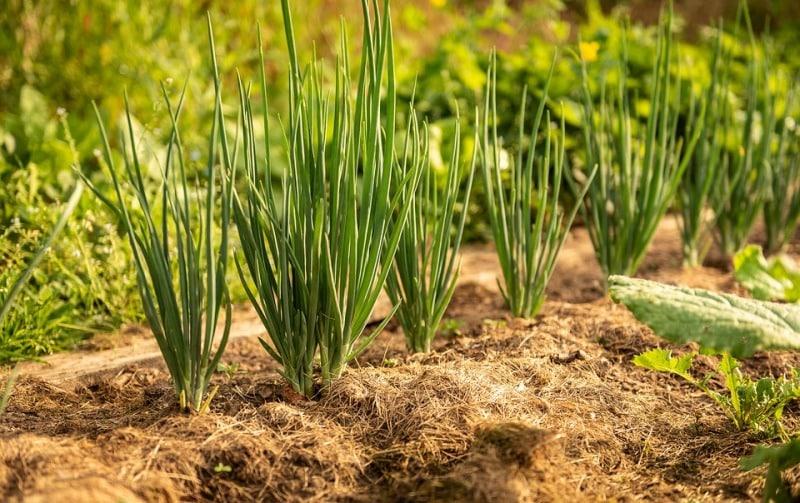Onion is a popular vegetable species and is most widely cultivated in India. People use it for culinary and non-culinary purposes, including moth repellent due to its pungent juice, polish glass and copperware, use as plants pest resistance, etc. India has the first place for doing Onion farming in terms of area. Also, it has a second-place after China in terms of production. Onion is a famous vegetable, and Indian people use it for making chutneys, salads, cooking foods, etc.
Climate for Onion Farming
If you want to cultivate onion for commercial purposes, you have to take care of some climate requirements. These requirements can give you the best results for your farm. So, let’s start with the temperature. Cultivate the onion at a temperature of 21 to 26°C for better results. Also, you can sow the seeds in a temperature range between 18°C to 20°C. The rainfall must be between 650 to 750mm for onion farming. And at the time of harvesting, the temperature must be between 25°C to 30°C.
Soil for Onion Farming
Farmers can cultivate it in various soils, including sandy loam, clay loam, silt loam and heavy soils. However, the deep loam and alluvial soils with sound drainage systems, sufficient organic matter and moisture-holding capacity can be the best option for onion farming. On the other hand, don’t cultivate it in loose and sandy soils because the bulbs can lose their keeping capacity. Moreover, a 6 to 7 pH level of the ground is suitable for onion farming. Also, you can use adequate farming machines like Swaraj 744 and others to increase productivity.
Popular Varieties
- Agrifound Dark Red: An average yield of 120 QTL/acre
- N 53: An average yield of 60-80 QTL/acre
- Bhima Shakti
- Bhima Dark red
Land Preparation
You have to take the soil to its fine tilth by providing 3 to 4 ploughings. Also, add well-decomposed cow dung so that the field can be rich in organic matter. Lastly, level the ground and separate it into small plots and channels. Remember to use good quality farming machines like Farmtrac 60 and others to prepare land perfectly.
Sowing
The middle of June month is the optimum time for raising the nursery. You can transplant seedlings after 6 to 8 weeks after sowing. And complete transplantation in August. Use 15 cm row space and 7.5 cm plant space for transplantation. Moreover, sow seeds at a depth of 1 to 2 cm depth using the transplanting method. The mentioned method of sowing is the best way to increase farm efficiency and productivity. Use it the same for better germination and production.
Seed
You can use 3 to 4 Kg of seeds in one acre of land. Treat the seeds with Thiram @ 2 gm/kg of seed and Benomyl 50WP@1 gm/litre water to keep seeds free from diseases. As we know, the sources are the prime thing to grow any crop. So we should use good quality seeds to get better results from the harvest.
Weed Control
Weeds are the curse for any agricultural outcomes. That’s why we should remove them from the land where we want to grow the crop. The weed-free land is more suitable for farming than weedy land. Following are some tips to keep your land weed-free.
Onion seedlings grow slowly at the initial stage. That’s why you should give chemical herbicides and weeding operations to the field to avoid injury. A spray of Pendimethalin @ 1 Ltr/200 Ltr water/acre can be helpful to remove weeds when you give it within 72 hours of sowing. And after 7 days of planting, you can give oxyfluorfen @ 425 ml/200Ltr of water/acre. Apply 2 or 3 weedings, first after one month of sowing and second after one month of the first weeding.
Irrigation
Decide the Irrigation frequency and amount upon the climate condition. So, immediately apply first irrigation after sowing. Then the rest of the irrigation depends on the climate condition. Apart from this, we should not give excessive water to the field as it can harm the crop and can be the reason behind extra vegetative growth.
Plant Protection
Plants can be affected by pests and diseases. That’s why we should apply some treatments to treat the crop.
- Purple blotch and stem phylium blight: Spray of Propineb 70% WP @ 350gm
- Maggots: Apply Chlorpyriphos @ 1.5Ltr/acre
- Thrips: Spray of Fipronil (Reagent) @ 30ml
Harvesting
It is necessary that you harvest the field at a proper time. And the appropriate time depends upon the season, variety, market price etc. The harvesting can be determined when 50% of the neck falls. After that, you should manually harvest the crop by uprooting the bulbs. And after harvesting, keep the bulbs in the shed so the moisture of the bulb can be removed properly. Now you should pack and grade the bulbs according to size and shape.


